IN CONFIDENCE
8 March – Item 6
Item 1 of 8
4 March 2022
To: Members, COVID-19 Chief Executives Board
COVID-19 - Importance of Social Cohesion for the Response
Purpose
1982
1. This paper provides the COVID-19 Chief Executives Board (CCB) with an overview of
the importance of Social Cohesion for the COVID-19 response in Aotearoa New
Zealand, the impacts on public confidence and social licence (key enablers for a Act
successful COVID-19 response), and an overview of the current work being done to
enhance social cohesion in our response to COVID-19.
Context
2. Aotearoa New Zealand’s response to COVID-19 has been one of the most successful in
the world in preventing deaths from COVID-19. A significant factor in our success to date
has been strong public trust and confidence in the response and effective use of
communications. However, two years of pandemic response, responding to multiple
COVID-19 variants and living with public health led restrictions has taken its toll on New
Information
Zealanders. At the same time, there has been a marked increase in sharing false and
misleading information since the onset of the virus, which also erodes public confidence.
3. Social Cohesion is participation and belonging, underpinned by high public trust in
government which in turn provides social licence. The OECD defines a cohesive society
as one that works towards the well-being of all its members, fights exclusion and
Official
marginalization, creates a sense of belonging, promotes trust, and offers its members
the opportunity of upward mobility1. See Annexure 1 for the dimensions of social
cohesion and factors contributing to breakdown.
the
4. MSD are currently leading a work stream on improving and fostering social cohesion. In
New Zealand, agencies’ social policies refer to five key characteristics of social
cohesion2: belonging, participation, inclusion, recognition, and legitimacy. However,
these characteristics in isolation could overlook the importance of creating and
maintaining public trust and mitigating risks to social cohesion such as disinformation.
under
5. Declining social cohesion is a culmination of factors, some were pre-existing and have
been exacerbated by COVID 19. It is important to also recognise the ongoing contention
-
standing conflict and perception of threat to minority right. Low social cohesion can
create parallel societies that inhabit different communications spaces, challenge
credibility and legitimacy of government action and risk eventually undermining
democracy.
Released
1 Sustaining Aotearoa New Zealand as a Cohesive Society. Sir Peter Gluckman, Dr Anne Bardsley, Professor
Paul Spoonley, Dr Charles Royal, Naomi Simon-Kumar and Dr Andrew Chen. December 2021
2 Ibid
IN CONFIDENCE
Page 1 of 9
IN CONFIDENCE
8 March – Item 6
6. Public support for the COVID-19 Public Health measures at the start of the response
was 74%3. Noting the initial success of the elimination strategy as a team of 5 million, the
country is now adapting to living with COVID-19 in the community and a high trust
model. With the introduction of omicron and the change in public health measures, this
has dropped to 64%4. The majority of New Zealanders continue to support public health
measures but there is a communication challenge in combatting pandemic fatigue,
change fatigue, and confusion.
Key risks to Social Cohesion in Aotearoa New Zealand in the COVID-19
environment.
1982
Widening Social Disparity
7. Socioeconomic division and wealth inequality has been highlighted and exacerbated by
COVID-19. Economic related factors diminished social cohesion include:
Act
a. Job insecurity - changing labour markets, precariousness of work because of self
-isolation rules and businesses not being able to continue operating.
b. Economic grievances and expectations – growth in anxiety/anger about changes
to the economy and labour markets.
c. Inequality of opportunity to access health, education.
This has fuelled a need for greater welfare support for the individual and for businesses,
Care in the Community programmes, and additional funding for Maori and Pacific
providers facilitating end-to-end support fits with local and regional models and needs.
Information
Impacts of false and misleading information and online harms
8. There has been a significant increase in the spread of false and misleading information
as the COVID-19 response has evolved. Many of the narratives around COVID-19
vaccines and the CPF are woven into larger themes centred around mistrust of
authorities and international businesses and relate to concerns about side effects, safety
and long-term effects of the vaccine and perceptions of COVID-19 restrictions. Many
Official
themes originate from outside New Zealand but are tailored to New Zealand audiences.
9. False and misleading information and online harms can be defined as follow:
the
Misinformation: Information that is false but not created with the intention of
causing harm. (e.g. a social media post that has been shared as it looks
credible)
Disinformation: Information that is false and deliberately created to harm a
person, social group, organisation or country (e.g. Ideological and/or politically
motivated extremism; deliberate campaigns to undermine public health etc.)
under
Mal-information is information that is based on reality, used to inflict harm on
a person, organisation or country.
Online bullying is when a person uses digital technology to send, post or
publish content intended to cause harm to another person.
Distressing content is content that is hateful, sexual material or illegal
material (like age-restricted material or extreme violence).
Released
3 News Talk ZB Poll reveals public's view on vaccine mandates https://www.newstalkzb.co.nz/news/covid-
19/covid-19-delta-poll-reveals-public-support-for-vaccine-mandates/. Accessed 2nd March 2022 (Published Tue,
16 Nov 2021)
4 Stuff.co.nz. Parliament protest: New poll shows 30 per cent of Kiwis support anti-mandate protest
https://www.stuff.co.nz/national/politics/127808790/parliament-protest-new-poll-shows-30-per-cent-of-kiwis-
support-antimandate-protest Accessed 2nd March 2022
IN CONFIDENCE
Page 2 of 9
IN CONFIDENCE
8 March – Item 6
10. Most false information is spread by people who may not be aware that it is false,
however, there a are a small groups of people within New Zealand and overseas
who actively share disinformation and seek to cause harm by threatening public safety,
fracturing community cohesion and reduce trust in democracy. Refer to the mitigations
table below current disinformation mitigation strategies.
International trends and influences
2. There are over 25 countries experiencing protesting related to COVID-19 including
noncompliance to social health measures and economic loss, social inequities and
1982
negative treatment of health staff5. Digitalisation has reduced the importance of spatial
boundaries between countries, and protestors may believe they have more in common
with their online communities than their national community. The technology that we
have used to keep people safe is being used in an increasingly coordinated way to
Act
enable disinformation to be spread. The impact and influence of the widespread
protesting overseas has undoubtably contributed to current situation in New Zealand,
given the obvious comparisons between the convoy in Canada which impacted supply
chains and bought Ottawa to a standstill and the domestic-convoy that has recently
occupied Parliament lawn.
3. The implications of seeing other countries lift some or all restrictions and move to a
semblance of ‘pre COVID-19’ is an inaccurate perception because they have been
through widespread outbreaks. However, this influences the way New Zealanders feel
about the stage of the COVID response we are currently in. It may contribute to feelings
Information
of restriction, fatigue and global isolation. The borders opening, may help reduce this
feeling of isolation from the rest of the world. But there is still a perception that New
Zealanders are excluded from what the rest of the world can do and that the rest of the
world is moving on.
Proportionality of public health measures
Official
“The global pandemic is a perfect human rights storm. The eye of the storm is striking a fair
and reasonable balance between, on the one hand, the rights to life, healthcare, and health
protection and, on the other hand, the rights to movement, work, education, and other
the
human rights” – Paul Hunt, Chief Human Rights Commissioner6
4. Proportionality of public health measures in a rapidly changing pandemic landscape
requires constant review. A disconnect between public health advice and decision
making with the everyday experience of the public could be perceived as breaching
under
human rights obligations (NZBORA). The public may perceive a greater feeling of safety
in 2022 given vaccination levels and the relative mildness of the Omicron variant despite
spreading easily. Issues include:
Fatigue to public health measures generally – less compliance to mandates such
as scanning in.
Change fatigue - clarity of phases as they are continually refined causing stress
and impact on businesses.
Different pandemic experiences between the regions – public health led
restrictions may feel harsher where there are less active COVID-19 cases, or in
Released isolated or rural communities.
5 Carnegie Endowment for International Peace. Global Protest Tracker.
https://carnegieendowment.org/publications/interactive/protest-tracker? Accessed 27th Feb 2022
6 Paul Hunt - Chief Human Rights Commissioner | Facebook https://www.facebook.com/PaulHunthrc Post from
12th February 2022.
IN CONFIDENCE
Page 3 of 9
IN CONFIDENCE
8 March – Item 6
Ability to comply with public health measures – this may be due to accessibility to
testing sites and/or Rapid Antigen Tests (RATs)
Compliance with self-isolation –
o Businesses negatively impacted by COVID-19 may not be supportive of
self-isolation requirements as this may result in difficulty staffing the
business
o Some workers may feel they cannot, due to financial reasons, self-isolate
if they test positive for COVID-19.
o Some parents may wish for their children to attend school, and not miss
out on any further education, which may impact their compliance with self-
isolation.
1982
Perceptions of division
o Restrictions based on public health recommendations require social
license for the population to support. Policies that are emotionally charged
Act
such as child vaccinations, loss of employment due to vaccination status
and accessibility to everyday activities are vulnerable to disinformation.
5. Collective responsibility is more important now the public is moving into phase 3, a high
trust model. If we have lower social cohesion, the public may feel less community
responsibility and could be more likely to act within their self-interests. The self-isolation
guidelines are already impacting the ability to work, affecting the supply chain, hospitality
and transport sectors and reducing access to education. Restricting some personal and
individual freedoms is necessary to slow the spread of COVID-19 to protect vulnerable
individuals and reduce impact on the health system. Information
6. An exacerbating factor to individualism over community responsibility is how many
regions have experienced the pandemic differently, and this may contribute to the
observed sentiment of COVID-19 fatigue7. Overall, 88% of people said they would self-
isolate if they were asked to. Some of the issues relating to self-isolation however are;
not enough space to isolate (57%), inability to take time off work (45%) and sharing a
room with someone in house (44%)8. Auckland has the highest density especially in
Official
lower socioeconomic areas like South Auckland where crowded living is more prevalent9.
A little over 10%10 of our population live rurally, not to allude they are unaffected by the
restrictions, but geographically it is easier to self-isolate, not to wear a mask and not to
the
require vaccine passes for everyday life11. The regions are experiencing the pandemic
differently and there is less imperative to be part of the whole.
7. Less adherence to self-isolation will result in the faster spread of COVID-19 and the
impact will ultimately be felt by the health sector. Already during this outbreak, testing
was overcapacity and our hospital systems are reaching capacity, Auckland is at 80.3%,
under
Capital and Coast are at 90.3% and Canterbury is at 90.5%12. There is a perception that
government had 2 years to prepare the health sector, vaccinate the public and instil good
7 Family First New Zealand. Vaccine Mandate Pol February 2022 by Curia Research http://familyfirst.org.nz/wp-
content/uploads/2022/02/Vaccine-Poll-Results-February-2022.pdf Accessed 25th February 2022
8 Attitudes to Self-Isolation February 2022 Final Report by Horizon Research
9 Stats NZ. Crowded housing highest among Pacific peoples https://www.stats.govt.nz/news/crowded-housing-
Released
highest-among-pacific-peoples. Accessed 2nd March 2022
10 Trading economics. New Zealand – Rural Population https://tradingeconomics.com/new-zealand/rural-
population-percent-of-total-population-wb-data.html. Accessed 2nd March 2022
11 Ibid
12 Stuff.co.nz New Zealand's hospital and ICU beds in numbers, as Omicron cases rise
https://www.stuff.co.nz/national/health/coronavirus/300530304/new-zealands-hospital-and-icu-beds-in-numbers-
as-omicron-cases-rise Accessed 2nd March 2022
IN CONFIDENCE
Page 4 of 9
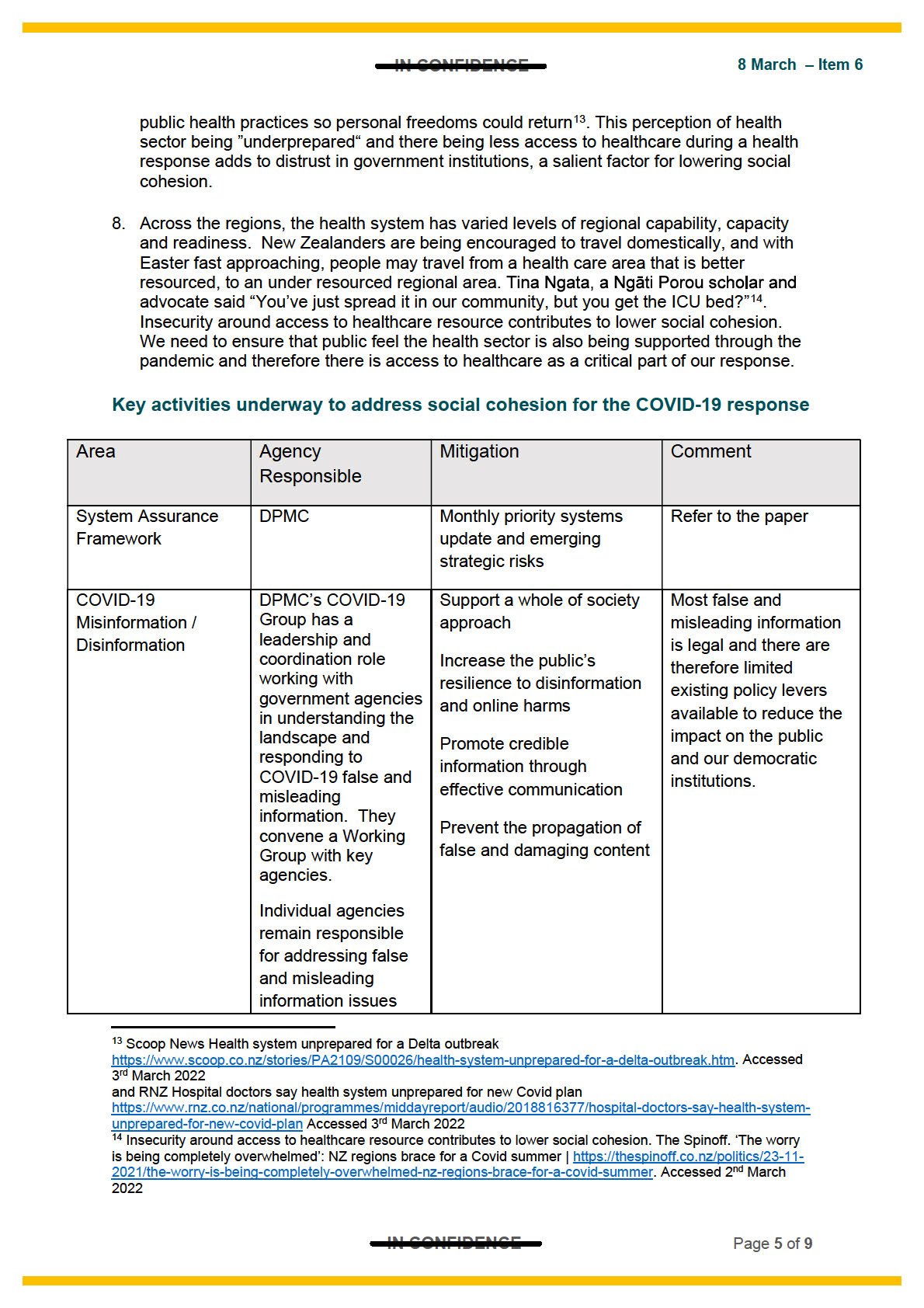
1982
Act
Information
Official
the
under
Released
IN CONFIDENCE
8 March – Item 6
that relate to their
specific portfolio
areas.
Communications and DPMC Strategic
Social cohesion focus
Engagements
Communications
retaining trust and
Develops and delivers
confidence
public communication
messages regarding the
Consideration of how to
COVID-19 response,
empower individuals in
1982
including the Unite Against
decision making and
COVID-19 campaign.
take individual
ownership of health
Act
Engages with COVID-19
considerations.
response agencies
regarding key messages for Engage with the public
the public both nationally
on the transparent and
and regionally.
democratic processes
in New Zealand relating
to COVID-19.
Reviewing public
DPMC
There is a policy review of
The Human Rights
health measures in
health measures underway, Commission issued
Information
the context of
including the CPF, with a
three briefings
Omicron, including
report back planned for
(published 24 Nov
the CPF
March.
2021) outlining
conditions that need to
This will include a review of
be met for human rights
My Vaccine Pass and
Official
and Te Tiriti in relation
whether any amendments
to the CPF and the use
are recommended.
of CVCs. There is a
the The COVID-19 Strategic light-touch piece of
Public Health Advisory
work underway by
Group have been asked to
DPMC to seek
provide advice on health
evidence and
measures.
assurance about what
under
processes are in place
to have met and
continue to meet these
conditions.
Social Welfare
MSD, TPK
Care in the Community
Supports locally led
support
programme and additional
response which fits with
funding for Maori and
local and regional
Released
Pacific providers facilitating
models and needs.
end-to-end support.
IN CONFIDENCE
Page 6 of 9

1982
Act
Information
Official
the
under
Released
IN CONFIDENCE
8 March – Item 6
Transparency of
All agencies
Public trust and confidence
It is important that
decisions
is built through
independent experts
transparency of decisions.
continue to provide
commentary that both
This is achieved this
support and criticise the
through access to media,
government’s response
media stand ups, publishing because it provides an
papers, comms releases.
insight into the balance
between individual 1982
rights and collective
wellbeing. Act
Future settings and challenges
9. The idea that removing CPF settings and public health mandates so that we can have a
clean exit from the pandemic is unrealistic “The pandemic is like a doorway. Once you
pass through, there is no going back”15. Providing stability in the future after an
unpredictable time is multifaceted and extremely difficult. Clear communication, a shift to
self-management and taking a more community-based approach given the differences in
regions is likely to continue to be critical.
Information
10. Addressing misinformation and disinformation requires exploring new and diverse
approaches to mitigate the consequences of false information as part of a wider
government approach. The current extent of our available policy levers is limited, and all
public health messaging must compete in an already overcrowded COVID-19
information space. Building resilience and proactively addressing disinformation and
online harms needs dedicated funding and a clear lead agency.
Official
11. We have now moved to a high trust and self-monitored response, this provides an
opportunity for community level initiatives that promote participation and inclusion with a
strong equity lens, which in turn will hopefully help to build social cohesion.
the
Recommendations
12. I recommend the COVID-19 Chief Executive Board members:
a. Note that the paper is a high-level overview of the importance of social cohesion
for the COVID-19 response.
under
b. Note Social Cohesion impacts and factors (Annex 1) should be considered when
making policy recommendations.
c. Note that there are a number of work programmes underway which may help
mitigate the social cohesion risk.
d. Agree to direct additional work if needed.
Prepared by: Jess Gray, Senior Advisor, System Assurance and Continuous Improvement
Released
Approved by: Amber Bill
Head of System Assurance and Continuous Improvement
COVID-19 Group, DPMC
15 The economist “The New normal is already here. Get used to it.” Printed 18/12/2021
IN CONFIDENCE
Page 8 of 9
IN CONFIDENCE
8 March – Item 6
Appendix A – Dimension of Social Cohesion and Factors relating to its
breakdown16
The dimensions of Social Cohesion
trust and respect between those who are governed and the institutions and individuals
they empower to govern them;
trust and respect between all members of a society (which by inference reflects a diverse
set of identities, worldviews, values, beliefs, and interests) to foster cooperation for the
good of the society as a whole;
Institutions and structures that promote trust and respect between all members of
1982
society; and allowing
Belonging, inclusion, participation, recognition, and legitimacy to be universally possible.
The dimensions of the breakdown of social cohesion are the inverse of the bullet points
Act
above. Factors include:
Inequalities
Inequality of opportunity to access health, education
Inequalities on wealth/income resulting in greater socioeconomic divisions
Economic insecurity and perception of unfairness
Job insecurity - changing labour markets, precariousness of work because of self -
isolation rules and businesses not being able to keep going.
Economic grievances and expectations – growth in anxiety/anger about changes to
the economy and labour markets.
Information
Information and public discourse
Changing role of traditional media – distrust in the fourth estate, choosing to act on
feelings over reasoning/ logic / factual data.
Social media impacts – spreading of disinformation and misinformation.
Declining information reliability – overwhelm of information, uncertainty on the
information given.
Social Boundaries and norms
Official
Sense of collective responsibility – a more individual approach to the pandemic. Less
shared values i.e. is public health importance versus economic importance.
Compliance with civic values – less respect for norms e.g. wearing a mask/scanning
the
in.
Psychological states and stresses
Sense of personal security and safety – real threat of getting COVID-19.
Emotional and psychological stress – experience of lifestyle under the current
framework; limited gatherings, working from home, self-isolating etc.
Trust in government institutions
under
Trust in a representative democracy – declining public trust in government
accountability and integrity; perceived lack of voice.
Trust in government institutions – public trust in the agencies of central and local
government, and that government will meet individual and community needs.
Inclusion and community
Perceptions of minorities – blame and stereotyping of ‘out groups’.
Strength of community groups – community support.
Sense of nationalism – ties in with the sense of collective responsibility and
diminished sense of being in the pandemic together.
Released
16 Sustaining Aotearoa New Zealand as a Cohesive Society. Sir Peter Gluckman, Dr Anne Bardsley, Professor
Paul Spoonley, Dr Charles Royal, Naomi Simon-Kumar and Dr Andrew Chen. December 2021
IN CONFIDENCE
Page 9 of 9
IN CONFIDENCE
26 July 2022 – Item
Item 2 of 8
20 July 2022
To: Members, COVID-19 Chief Executives Board
DPMC COVID-19 Group Transition: Update
Purpose
1982
1. This paper provides an update on the transition of the functions of the DPMC COVID-19
Group following Cabinet’s decision to move to a more enduring decentralised
Act
governance and operating model.
Background
2. On 4 July Cabinet agreed to a phased transition of the high-level set of functions
currently residing within DPMC’s COVID-19 Group to health and border agencies over
the course of this financial year (SWC-22-MIN-0118 confirmed by Cabinet).
3. Timing for transition will be driven by the readiness of the receiving agency to take on the
Information
functions and completion of a due diligence process. This process is being conducted by
DPMC and the agency receiving the function. All aspects of the transfer of each function,
including the infrastructure, funding, contracts and people involved will be carefully
considered, so we can ensure that transition is successful and seamless from the
perspective of Ministers and the public. The process will be transparent and inclusive for
Official
those staff affected. It will reflect that we are still operating in a pandemic situation.
4. In addition to the due diligence process, Ministers have directed that before any transfer
the
of functions from DPMC to the health agencies, an exercise be undertaken to ensure
system readiness to respond to a new variant of concern (see separate CCB paper on
this).
5. Final decisions on the timing and any appropriation changes will be taken by a subset of
under
Ministers. This group is the Prime Minister, Minister of Finance, Minister for COVID-19
Response, and Minister of Health.
Due Diligence Process
6. The due diligence process has commenced with initial meetings held between DPMC
and receiving agency nominated contact points. As part of the discovery phase,
Released
information is being collated and exchanged on how each function is delivered, and the
people, infrastructure and contractual arrangements involved. Subsequent discussions
will cover in detail how DPMC COVID-19 Group functions and people will integrate into
the structure of the receiving agency and what further information is required to ensure
transition is successful. Knowledge and information transfer will be part of the transition.
IN CONFIDENCE
Page 1 of 2
IN CONFIDENCE
26 July 2022 – Item
7. The extent of the process is expected to vary for each function to take into account the
specific characteristics and complexity of the tasks involved, but will follow a standard
process. This will include discussions with DPMC staff affected by the transition.
8. DPMC met with Treasury vote analysts for DPMC and Health to develop some guidance
for receiving agencies on what might need to be demonstrated to Ministers to meet the
very high threshold Cabinet expects for any existing DPMC COVID-19 funding to transfer
alongside any functions (noting that any existing funding runs out in June 2023).
1982
9. Given the current fiscal situation and that future budget allowances are tight, the
expectation is that costs arising from the transfer of people with functions or new staff to
undertake these (salaries and associated overheads) should be able to be absorbed
Act
within departmental baselines, especially in larger organisations with greater headroom.
10. Funding transfers may be considered for: 1) significant fixed costs, such as contracts or
other infrastructure that are needed to continue the COVID-19 response or 2) bespoke
capability or specialist roles not currently resident in the receiving agency that need to be
established in order to deliver the function. In both cases, the receiving agency will need
to demonstrate they are not in a position to reasonably reprioritise existing funding. This
guidance will be shared with contacts in receiving agencies who are working on
transition..
Information
11. The outcome of the due diligence discussions occurring over July and August will be
presented to each agency for endorsement at Chief Executive level and incorporated
into advice to the small group of Ministers who will take final decisions on the timing and
appropriation changes (if any). This is expected to be finalised in early September.
Official
Recommendations
12. I recommend the COVID-19 Chief Executive Board members:
the
a. Note initial due diligence meetings have been held with all agencies who will
receive functions currently undertaken by the DPMC COVID-19 Group
b. Note the expectation that the process will be concluded to enable advice to be
provided in September to the subset of Ministers who will take final decisions on
under
the timing of the transfer and appropriation changes, if any.
Ruth Fairhall
Deputy Chief Executive, COVID-19 Group
Department of the Prime Minister and Cabinet
Released
IN CONFIDENCE
Page 2 of 2
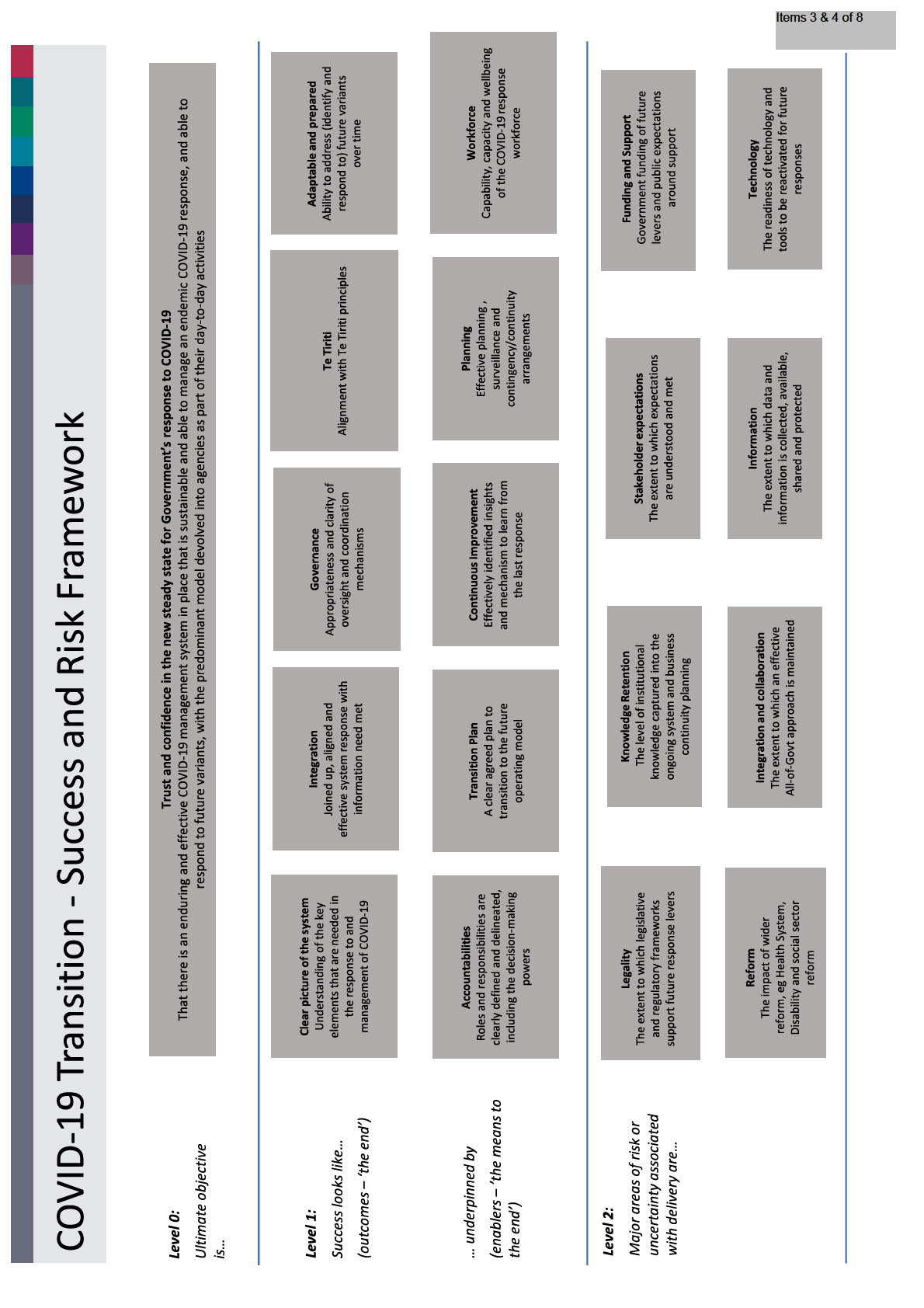
1982
Act
Information
Official
the
under
Released
IN CONFIDENCE
Item 5 of 8
COVID-19 Chief Executives Board
Terms of Reference1
Purpose of CCB
1. The role of the COVID-19 Chief Executives Board (CCB) is to provide system leadership
in navigating New Zealand through the COVID-19 pandemic over the next two to three 1982
years; ensuring that the system is informed; is doing what it needs to, at the pace required;
and that risks are identified and mitigated. CCB is accountable for providing system
assurance and oversight to Ministers.
Act
2. The establishment of CCB recognises that COVID-19 transcends traditional sector
boundaries, and that optimising New Zealand’s COVID-19 outcomes requires a joined-up,
all-of-government approach to system leadership.
Remit
3. CCB is established as a standing committee of the Officials’ Committee for Domestic and
External Security Coordination (ODESC) system. ODESC is mandated by Cabinet2 to
provide advice to Government on all matters of national security3, including pandemics.
New Zealand’s approach to national security is underpinned by seven key objectives
Information
including:
a.
Ensuring public safety — providing for, and mitigating risks to, the safety of
citizens and communities (all hazards and threats, whether natural or man-
made);
b.
Preserving sovereignty and territorial integrity — protecting the physical
Official
security of citizens, and exercising control over territory consistent with national
sovereignty;
the
c.
Protecting lines of communication — these are both physical and virtual and
allow New Zealand to communicate, trade and engage global y;
d.
Strengthening international order to promote security — contributing to the
development of a rules-based international system, and engaging in targeted
interventions offshore to protect New Zealand’s interests;
under
e.
Sustaining economic prosperity — maintaining and advancing the economic
wel -being of individuals, families, businesses and communities;
f.
Maintaining democratic institutions and national values — preventing
activities aimed at undermining or overturning government institutions, principles
and values that underpin New Zealand society.
4. CCB’s remit is:
Released
1 Updated and agreed on 28 June 2022
2 DES Min (11) 1/1
3 Cabinet has agreed a broad definition of security that includes civil contingencies and societal risks.
IN CONFIDENCE
Page
1 of
4
IN CONFIDENCE
a.
Overall system performance (including driving system-level collaboration and
coordination in respect to the COVID-19 work programme).
b. To
sponsor and
advise on the Government’s medium-term
COVID-19 strategy
(recognising that this is ultimately subject to ministerial direction).
c. To identify the
system-level risks and the
system-level priorities that flow from
this strategy.
d. To oversee the associated
work programme that addresses both the
strategy’s
priorities and
risks and to provide assurance to Cabinet on the same.
e. To provide
a point of escalation for complex decisions. This is particularly so 1982
in circumstances where it is not immediately clear where accountability at the
agency level should lie.
f. Overseeing the
development of the COVID-19 system transition plan to
Act
ensure it supports a shift toward a more sustainable mode of operation, while
retaining the ability to be responsive to changes in the evolution and
characteristics of the virus.
5. To achieve its remit, CCB is expected to:
a. Take a
holistic and strategic view (encompassing health, economic and social
outcomes across reduction, readiness, response and recovery).
b. Aid and promote a
common understanding of the Government’s strategy.
Information
Scope
6. It is expected that CCB wil primarily focus on COVID-19-related issues that involve more
than one sector or require a system response.
7. CCB wil provide advice to Cabinet on system priorities including the relative priority of
COVID-19 related work compared to other priorities. CCB wil also provide advice on the
Official
forward-looking work programme to support the Government’s COVID-19 strategy.
Decisions on CCB’s high level work programme, including the reallocation or prioritisation
of resources within or across the public service remain with Cabinet.
the
8. For the avoidance of doubt, nothing in these terms of reference should be read as affecting
or altering any responsibility or accountability for any statutory functions, duty, or power to
be performed or exercised by any Chief Executive or department represented on CCB, or
by any other Chief Executive or department within the remit of CCB.
under
Membership
9. Membership is set as described in Annex A. Membership may be amended as
New Zealand’s COVID-19 situation and strategy changes.
10. Members of CCB are Chief Executives who represent sectors; in most cases, members
also chair their corresponding sector governance board(s). Members are expected to
represent the views of the sector agencies and wider stakeholders (including iwi, private
Released
sector, NGOs and vulnerable communities as appropriate) at CCB, providing assurance
to CCB regarding their respective sectors, and keeping sectors and key stakeholders
informed about CCB discussions.
11. While each sector is structured differently, most are supported by a range of steering and
working groups.
IN CONFIDENCE
Page
2 of
4
IN CONFIDENCE
12. If a Chief Executive is unable to attend a CCB meeting, an acceptable delegate is another
Chief Executive within the relevant sector or a delegate who is formally acting as a Chief
Executive.
13. Additional CEs wil be invited to attend CCB if a topic is directly related to their portfolio.
14. CCB is chaired by the Chief Executive, Department of the Prime Minister and Cabinet
(DPMC).
Meetings
1982
15. Secretariat support for CCB wil be provided by DPMC’s COVID-19 Group. The secretariat
wil ensure the conditions are in place for sound strategic decision-making by CCB,
including supporting the Chair to identify and triage issues; working with CCB agencies to
Act
manage the Board’s work programme and system risks; ensuring that items are framed to
facilitate strategic discussions; and maintaining sound board practices (record keeping,
etc).
16. The frequency of CCB meetings wil depend on the circumstances and wil be determined
by the Chair in consultation with the members.
17. In the event of a significant resurgence or COVID-19-related crisis, the Chair may request
that ODESC convenes rather than CCB.
Information
Official
the
under
Released
IN CONFIDENCE
Page
3 of
4
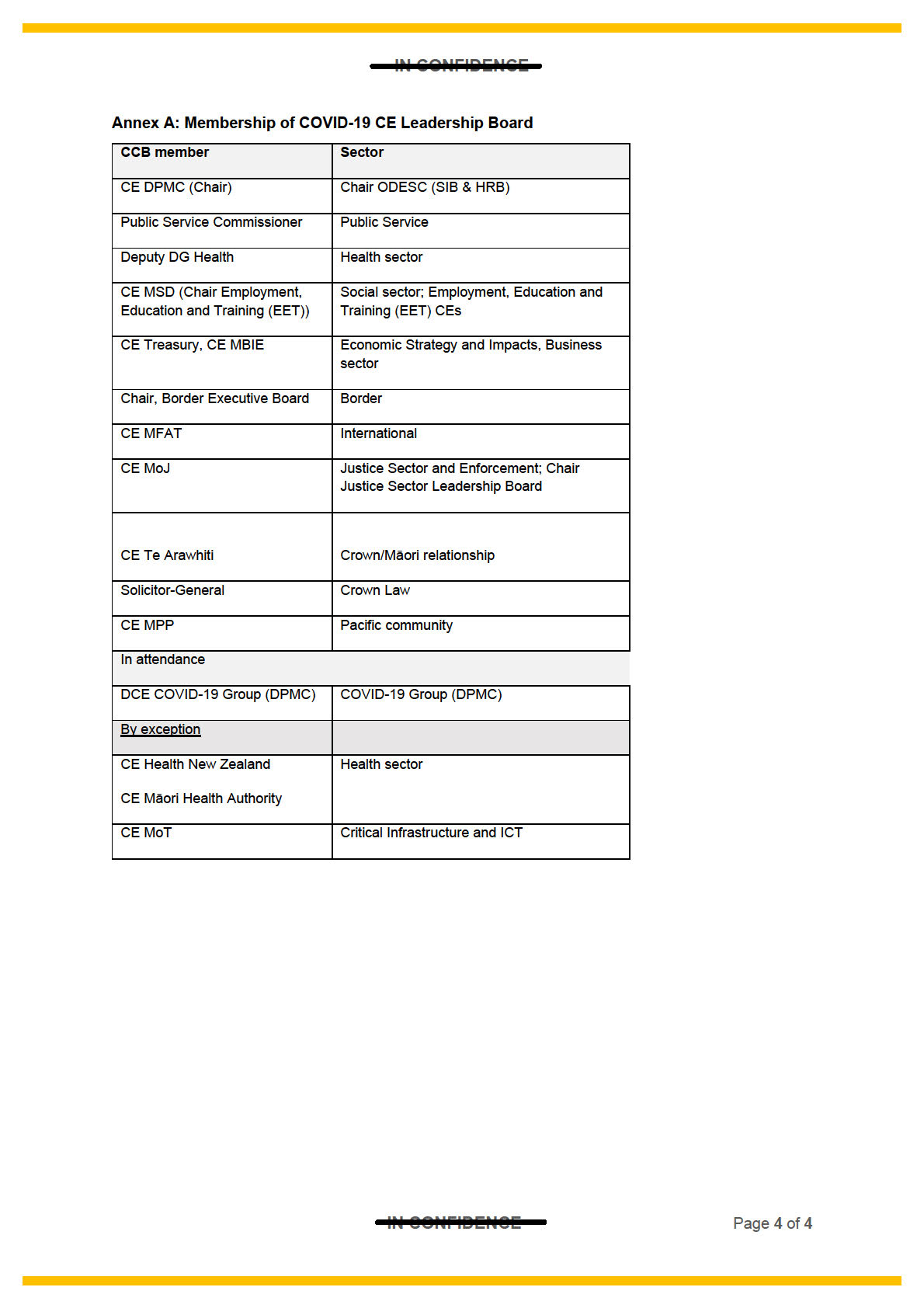
1982
Act
Information
Official
the
under
Released
IN CONFIDENCE
28 June 2022 – Item 6
Item 6 of 8
28 June 2022
To: Members, COVID-19 Chief Executives Board
Future CCB: Amendment to Draft Terms of Reference
Purpose
1982
1. On 14 June, I advised the Board that I would bring a paper outlining the future form of CCB
for discussion. This paper proposes frequency of meetings, slight changes to membership,
Act
and confirms a focus for CCB commensurate with a less centralised approach, a move
away from the emergency response-based arrangements but retaining a preparedness to
respond.
Context
2. The Board’s Terms of Reference were formulated in September 2020 and circulated to the
Board for the first meeting on 17 November 2020. There was a minor amendment in May
2022 to include the Board’s oversight role in the transition:
Information
Overseeing the development of the COVID-19 system transition plan to ensure it
supports a shift toward a more sustainable mode of operation, while retaining the ability
to be responsive to changes in the evolution and characteristics of the virus.
Official
3. CCB continues to have an important role to play across the transition. The Success and
Risk Framework (standing agenda item) provides a structure for CCB to continue to
monitor success and manage major areas of risk about transition.
the
4. Additionally, there is ongoing Cabinet and Cabinet Committee reporting needed. For
example, the Cabinet paper “COVID-19: Confirming New Zealand’s Approach to Variants
of Concern” requires report-backs including: a system readiness exercise before the
under
COVID-19 Group transitions; Health and Disability system preparedness; measures to
support improved ventilation; interim self-isolation at the border. The same paper also
notes a National Management Plan update will be prepared to provide a high-level
overview of the management of new variants within the context of the post-winter strategy
and future institutional structures.
5. There is also ongoing and significant legislative work for the next tranche of COVID-19
legislation which will require an experienced all-of-Government lens.
Released
6. Finally, with the potential disestablishment of the National Response Leadership Team
(NRLT), the CCB will also be the primary mechanism to guide an all-of-government
COVID-19 response should there be a requirement to convene with urgency. Our future
IN CONFIDENCE
Page 1 of 9
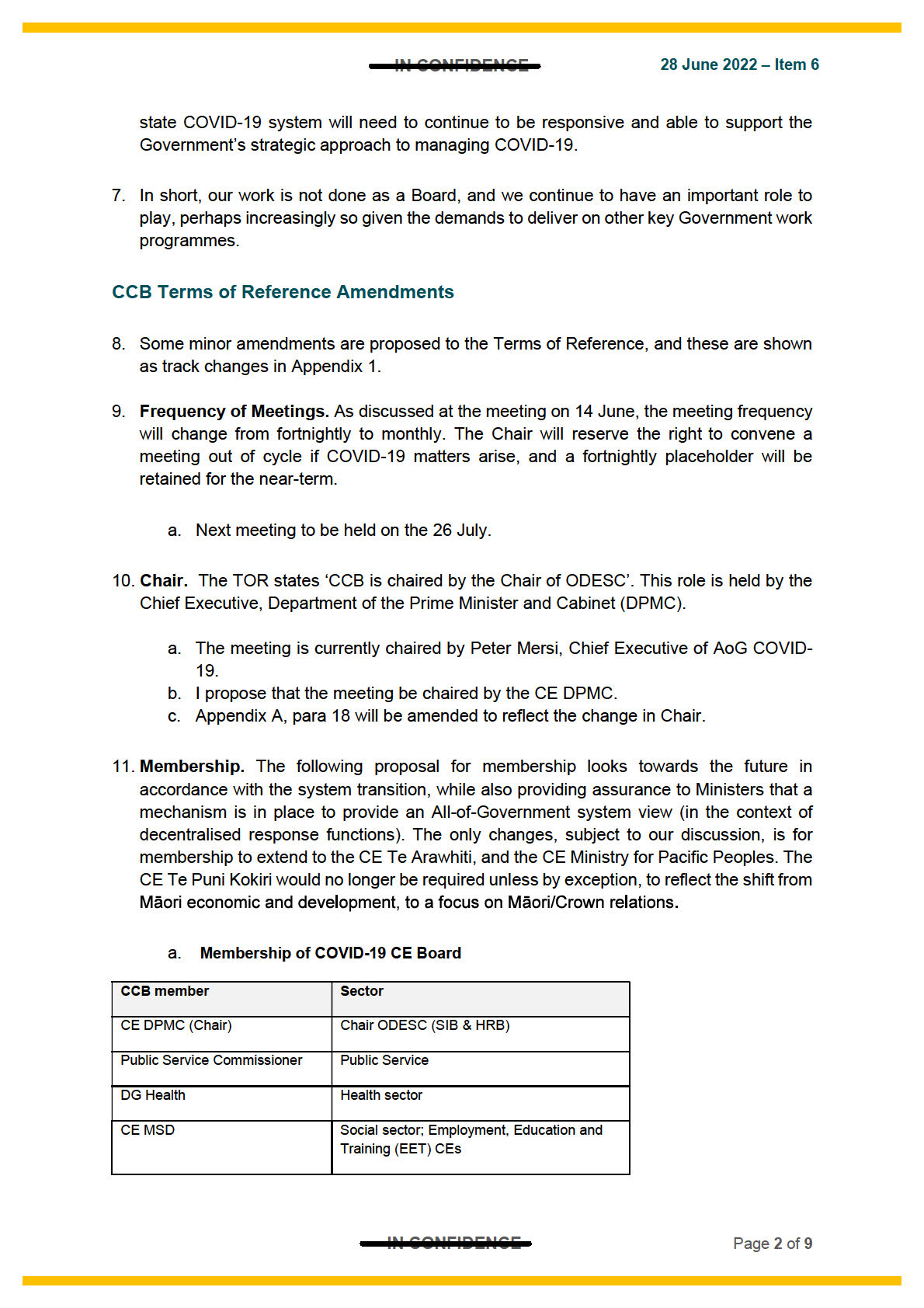
1982
Act
Information
Official
the
under
Released
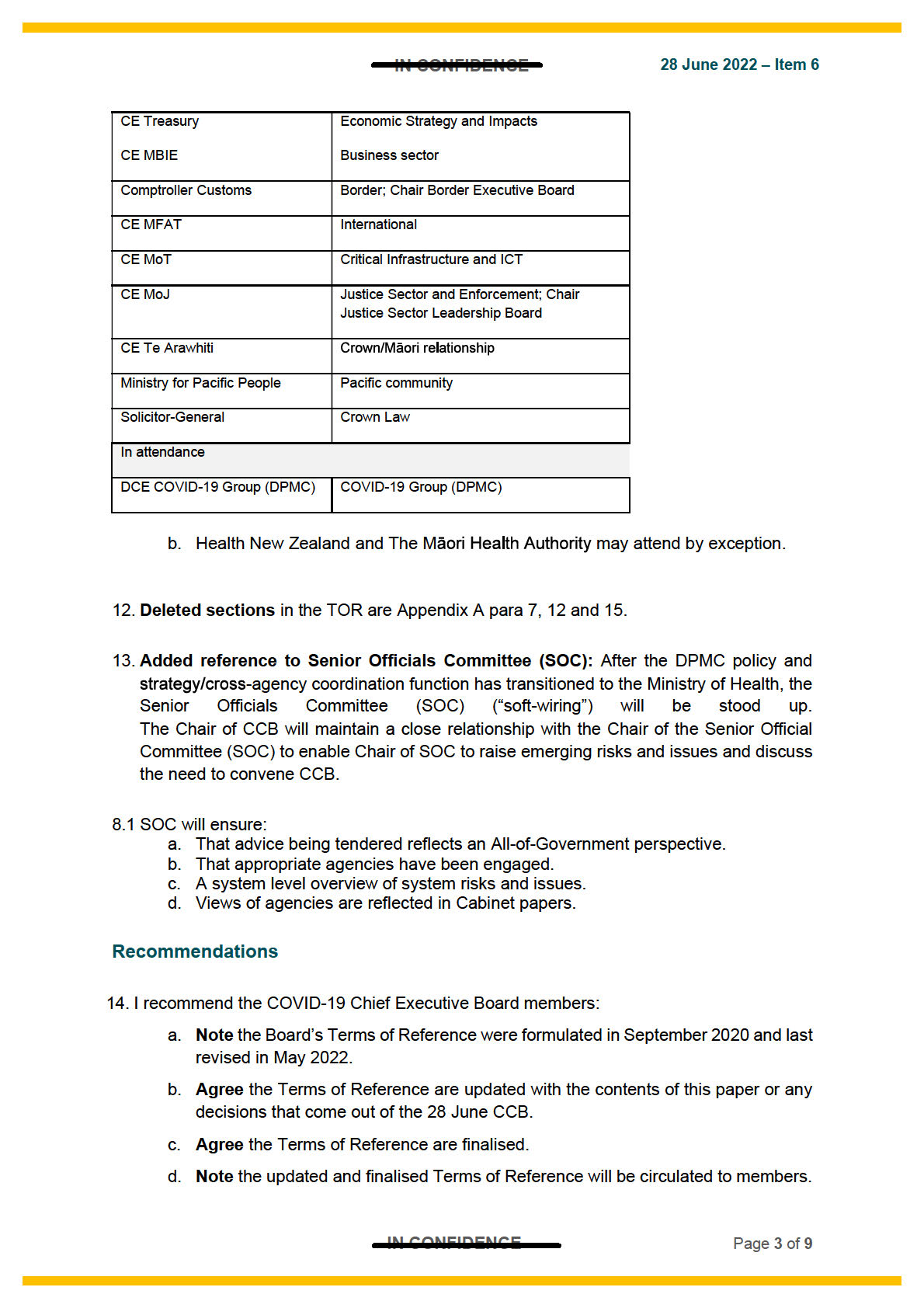
1982
Act
Information
Official
the
under
Released
IN CONFIDENCE
28 June 2022 – Item 6
Peter Mersi
Chief Executive All of Government COVID-19 Response and Chair of the COVID-19 Chief
Executives Board
Department of the Prime Minister and Cabinet
1982
Act
Information
Official
the
under
Released
Appendix A deleted as it is a draft version of Item 5
IN CONFIDENCE
Page 4 of 9
IN CONFIDENCE
26 July 2022
Item 8 of 8
26 July 2022
To: Members, COVID-19 Chief Executives Board
aper for Minister for COVID-19 Response:
Syste
Purpose
1982
1.
The purpose of this
paper is to provide the Minister for COVID-19 Response with an update
on activities underway to ensure the readiness of the COVID-19 system to respond to a
Act
new variant of concern.
Background
Recently Cabinet discussed the Government’s response to variants of concern that may
arise in the future, the changes to our COVID-19 strategy post-winter, and the legal and
institutional settings required to ensure our approach for managing COVID-19 is
sustainable over the longer term [CAB-22-MIN-0223; CAB-22-MIN-0251].
A priority for the Minister for COVID-19 Response is the readiness of the system to
Information
respond to a variant of concern. A key feature of the Cabinet papers was a series of
report backs to COVID-19 Ministers and Cabinet to give assurance that the system is
ready, particularly given the concurrent changes in institutional arrangements.
The
paper attached provides an update on the activities underway to give the
Minister for COVID-19 Response assurance that these activities are underway.
Official
Declaration of Readiness for the Catalogue of Measures (National Management
Plan)
the
Cabinet also agreed that as part of the readiness assurance, the National Management
Plan (NMP) will be updated to reflect the post-winter strategy and any changes to
institutional arrangements [CAB-22-MIN-0223].
The NMP steps through high-level guidance for the all-of-government COVID-19
response system, agencies’ respective roles and responsibilities, and guides the
under
system through the decision-making architecture.
A section of the NMP overviews the measures and settings available to manage
COVID-19 (including current and latent measures). A companion document, the
Catalogue of Measures, contains the operational details (eg, time to operationalise,
dependencies, accountabilities) for each of the measures.
This catalogue will also be updated to reflect the baseline and response measures in
line with the post-winter strategy.
Released
As part of the assurance provided to the Minister for COVID-19 Response (see
paragraph 24), the COVID-19 roup will seek confirmation from Chief Executives that
their agencies are aware of, and ready to activate the measures they are responsible
for, as set out in the Catalogue of Measures.
IN CONFIDENCE
Page 1 of 2
IN CONFIDENCE
26 July 2022
Chief Executives to review and report on readiness
10. In addition, Public Sector Chief Executives are required to keep their variant readiness
plans under review and fit-for-purpose across variant scenarios and provide to COVID-
19 Ministers regular updates on their variant of concern readiness [CAB-22-MIN-0223
refers].
11. The attached paper proposes a light touch method to support CEs to fulfil those two
requirements (see paragraphs 25-29, and below).
a) We propose that the lead agency for all-of-government coordination (ie, Ministry of 1982
Health) establish regular exercises (eg, twice annually) to provide assurance that
the system’s readiness is reviewed and informed by up-to-date understanding of
current variants of concern. Participation in this exercise could satisfy the
Act
requirement to review readiness plans (CAB-22-MIN-0223].
b) Following each exercise, a report could be provided to COVID-19 and serve as the
regular report backs to COVID-19 Ministers on readiness, satisfying the
requirements for regular reporting [CAB-22-MIN-0223].
12. I am seeking CCB’s views on whether this approach is appropriate and desirable.
Next steps
Information
13. Following this meeting, we will write to Chief Executives setting out the measures they
are responsible for and seek their confirmation of readiness by 19 August. This
assurance will be included in the report back to the Prime Minister and the Minister for
COVID-19 Response [CAB-22-MIN-0223 refers].
14. Assuming the CCB is comfortable with the paper attached, I will send the paper to
Minister for COVID-19 Response and the Prime Minister.
Official
Recommendations
the
15. I recommend the COVID-19 Chief Executive Board members:
a. Note the contents of the attached paper, “Assurance on system readiness to respond
to a variant of concern”
b. Note that Chief Executives will soon receive a Declaration of Readiness for the
under
Catalogue of Measures, as part of readiness assurance work, for completion by 19
August.
c. Agree that the proposal to incorporate CE report backs into regular exercising be
included in the attached paper
d. Note that the attached paper will be sent to the Minister for COVID-19 Response and
the Prime Minister.
Released
Rachel Sutherland
Manager of System Assurance and Continuous Improvement
COVID-19 Group, Department of the Prime Minister and Cabinet
IN CONFIDENCE
Page 2 of 2
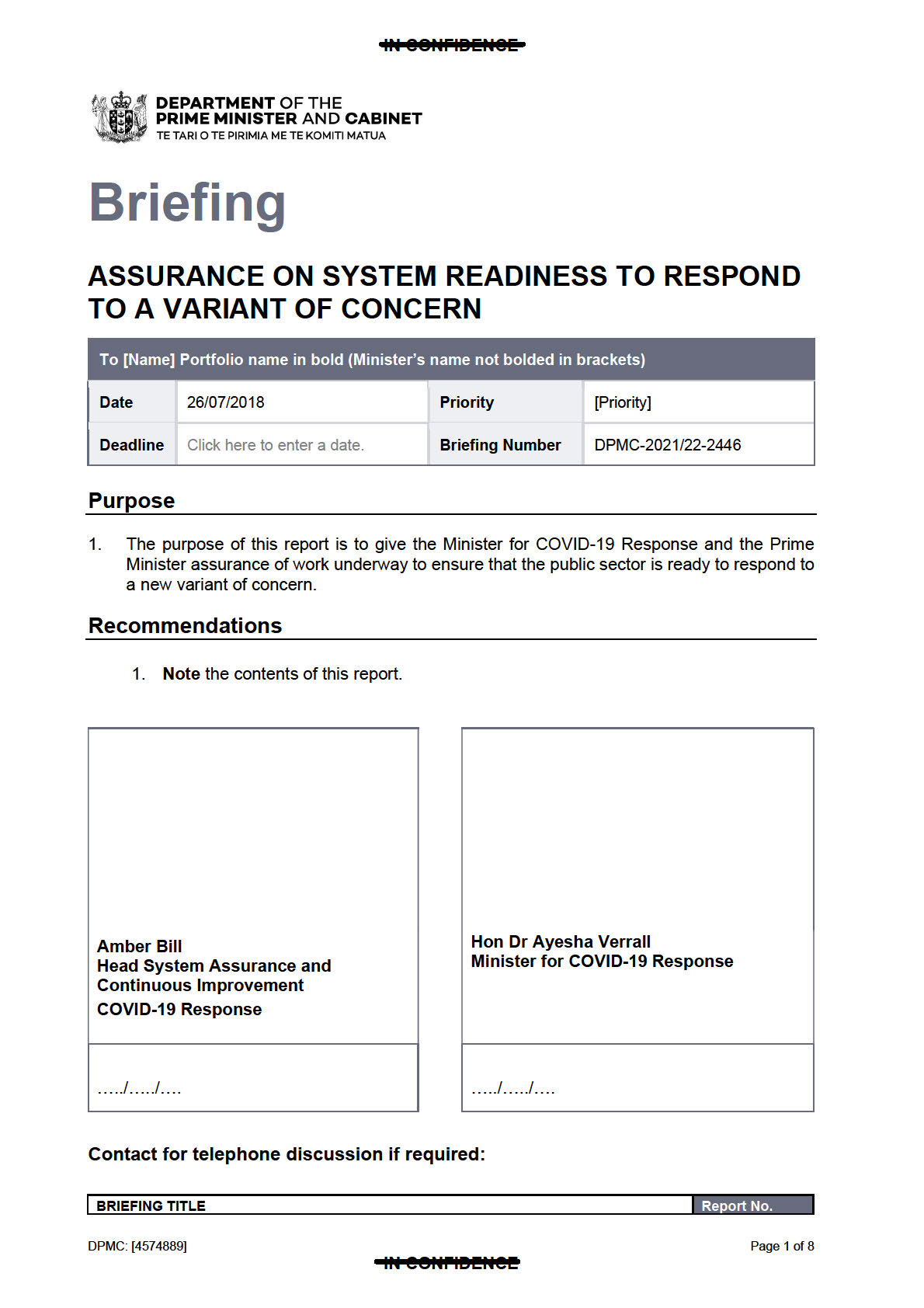
1982
Act
Information
Official
the
under
Released

1982
Act
Information
Official
the
under
Released
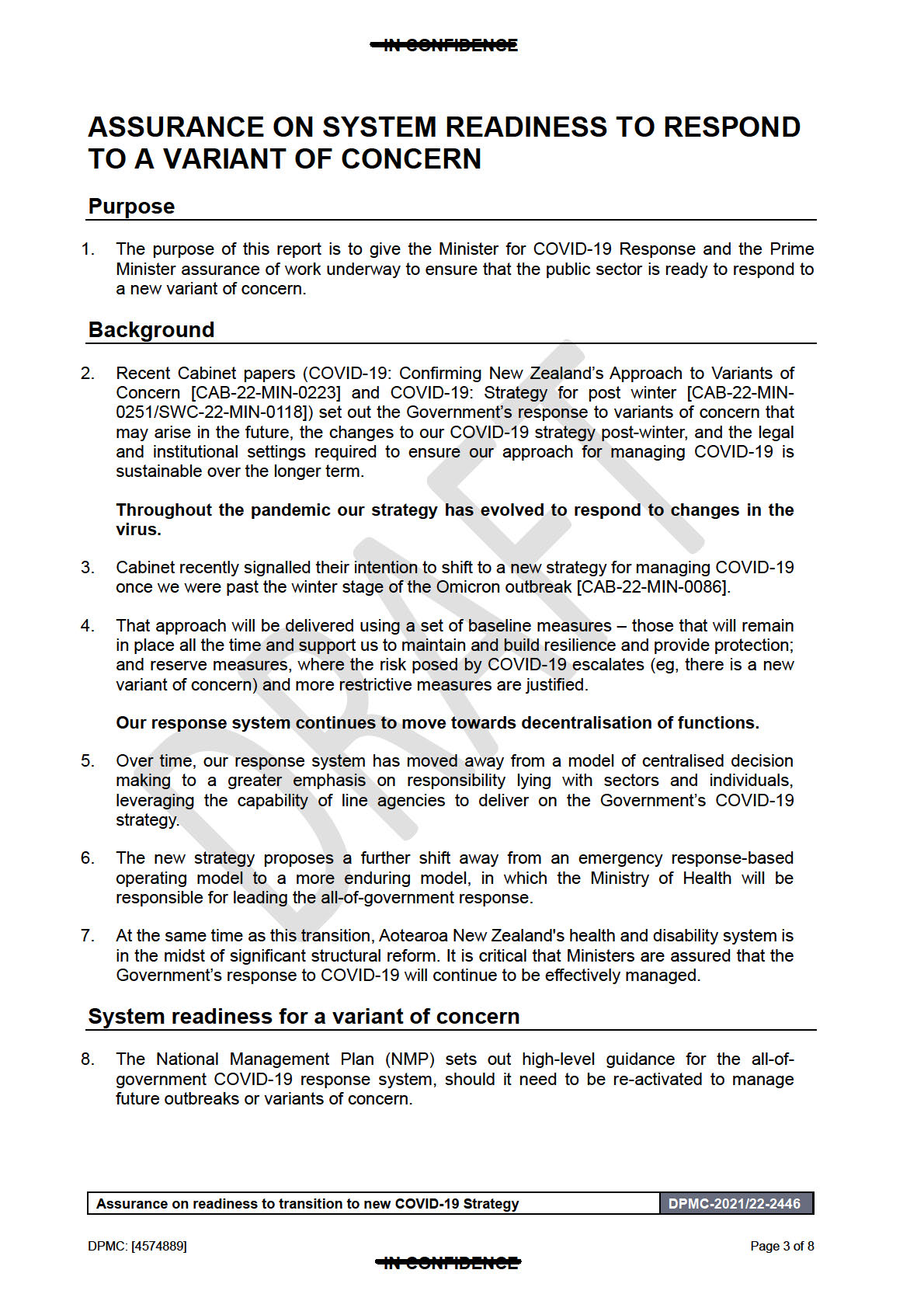
1982
Act
Information
Official
the
under
Released
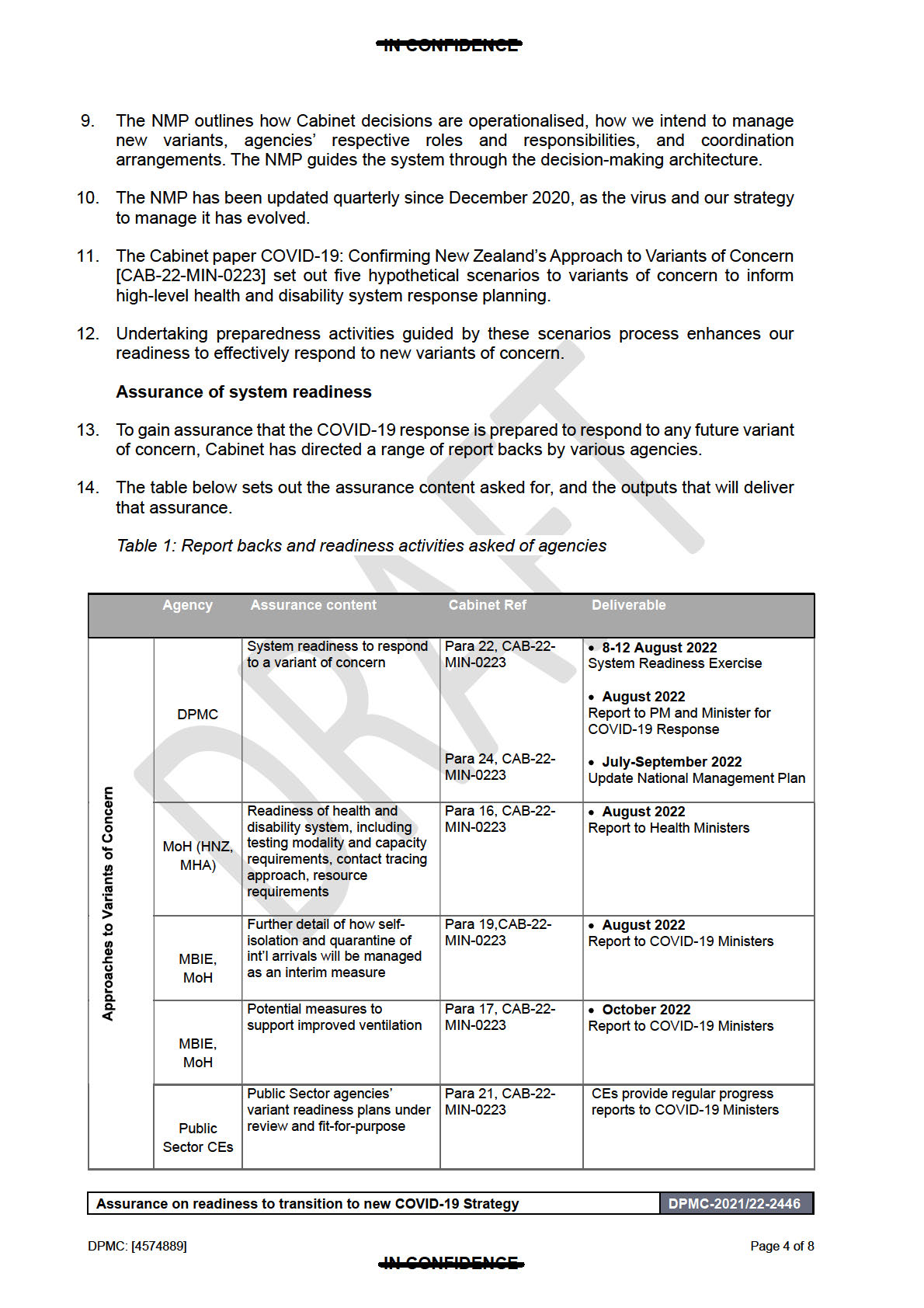
1982
Act
Information
Official
the
under
Released
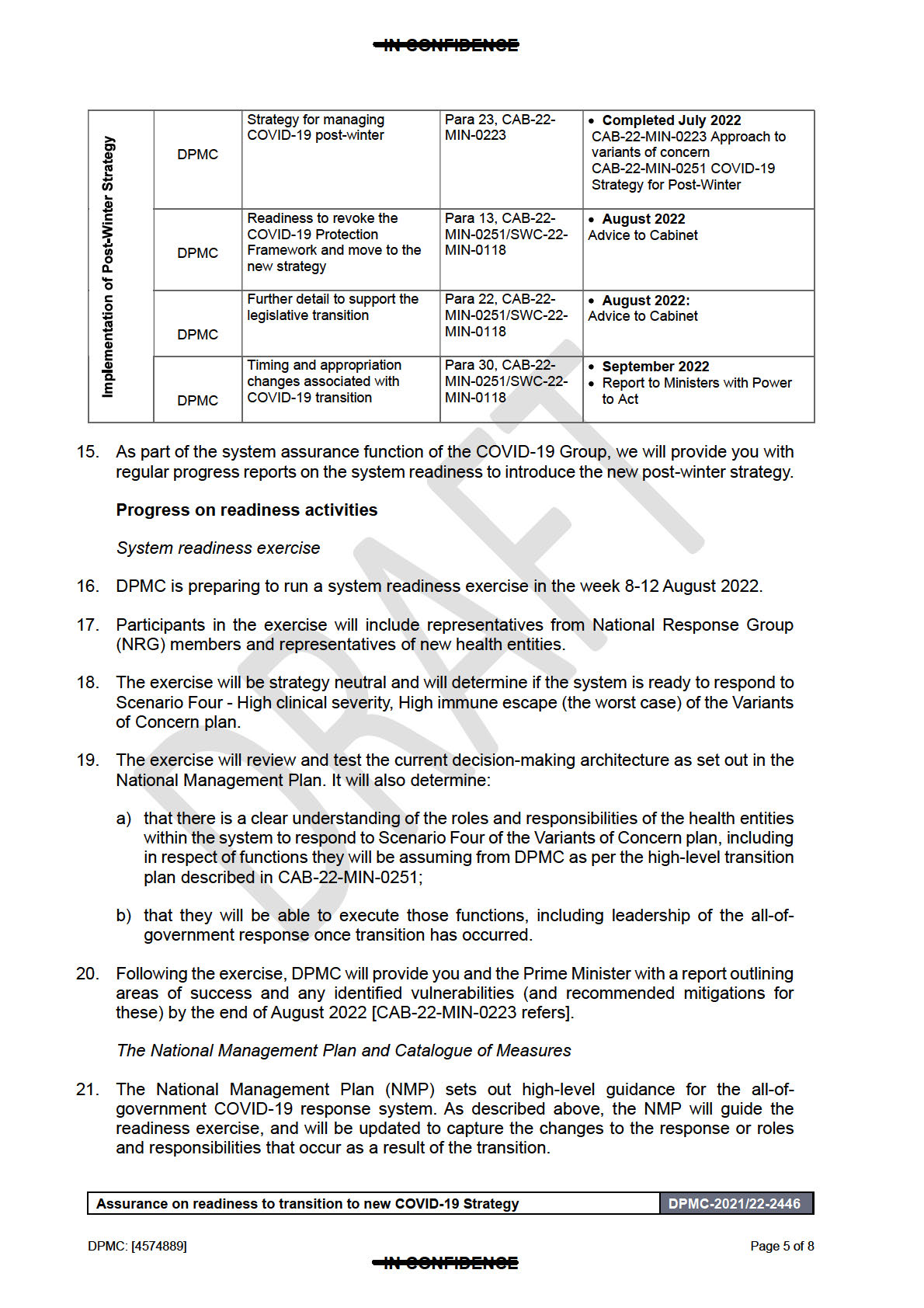
1982
Act
Information
Official
the
under
Released
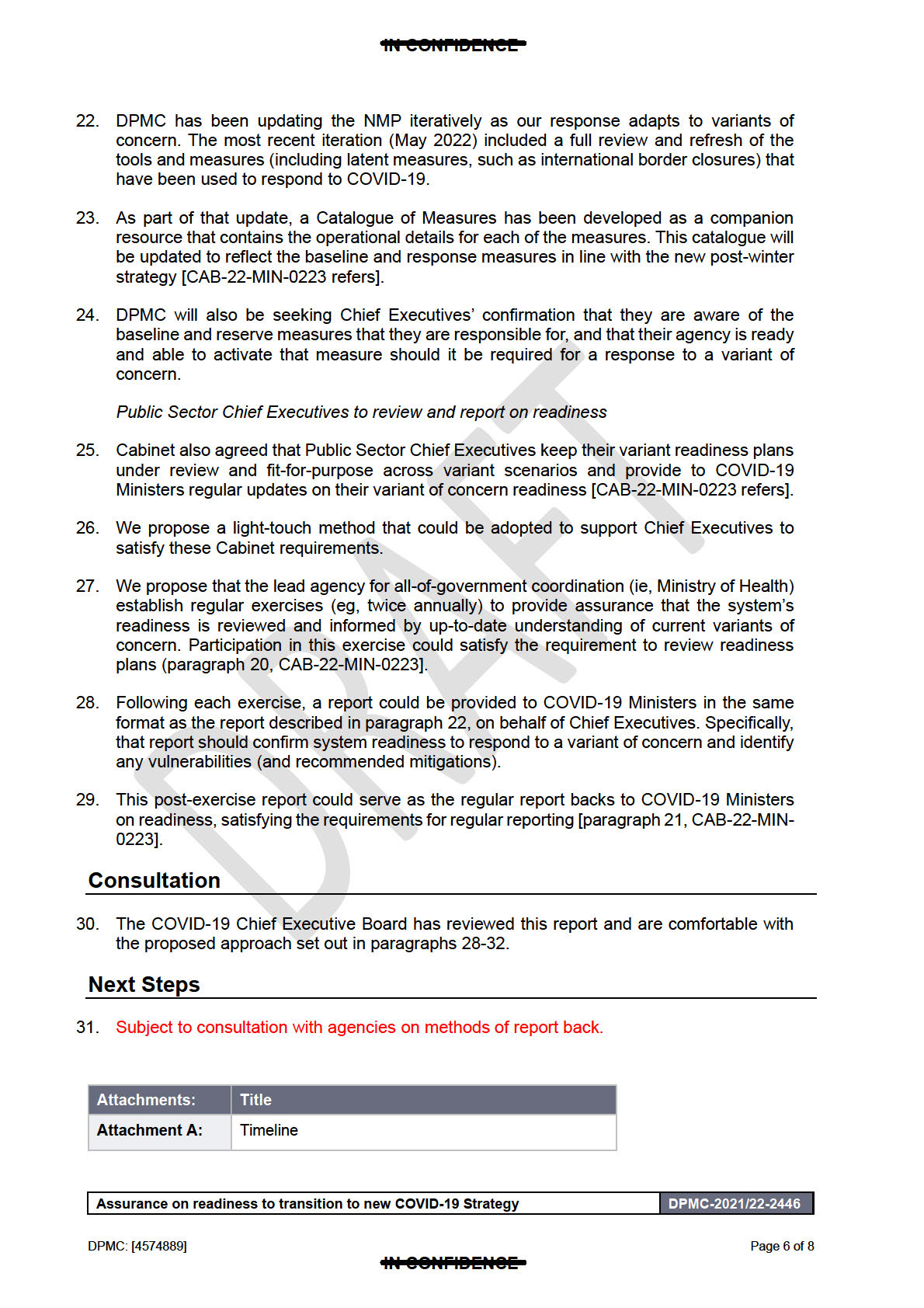
1982
Act
Information
Official
the
under
Released











